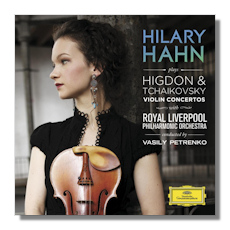
The Internet's Premier Classical Music Source
Related Links
-
Higdon Reviews
Tchaikovsky Reviews - Latest Reviews
- More Reviews
-
By Composer
-
Collections
DVD & Blu-ray
Books
Concert Reviews
Articles/Interviews
Software
Audio
Search Amazon
Recommended Links
Site News
 CD Review
CD Review
Higdon/Tchaikovsky

Concertos for Violin & Orchestra
- Jennifer Higdon: Violin Concerto
- Piotr Ilyitch Tchaikovsky: Violin Concerto in D Major, Op. 35
Hilary Hahn, violin
Royal Liverpool Philharmonic Orchestra/Vasily Petrenko
Deutsche Grammophon 4778777 68:16
Shortly after the release of this CD, Jennifer Higdon and Hilary Hahn were featured on the PBS News Hour and were interviewed for fifty minutes on NPR radio by Tom Huizenga on his blog called Deceptive Cadence. Both can be found online. This recording was eagerly awaited. The Higdon Concerto, dedicated to Hilary Hahn, was awarded the Pulitzer Prize earlier this year and the sheer appeal of the music and the performances on this CD were major factors besides.
I have been following the careers of both Higdon and Hahn for years, at live concerts in Milwaukee and Indianapolis, and on recordings. Indianapolis was where the Higdon Violin Concerto was premièred, on February 6, 2009, and I drove a long way to attend and review that concert. Having just reread what I said in my concert review, I am surprised at how much I noticed about the orchestration on a single hearing compared to what I've noticed in many hearings of the recording, during which I have paid much more attention to the violin part and to the concerto's formal development, which is hard to take in on a first hearing. This says much about the difference between a live concert and living room listening even with good equipment, I think. One thing about a live concert: you can see who is playing, if you have the right seat location. What recordings have going for them is obviously the possibility of repeated listening. Of course a number of orchestral timbres, from flute to trumpet and horn are certainly audible on this recording.
But what I am hearing now is how much more melodic the opening movement is than I had originally noticed. To be sure, there are some changes of pace and the lyricism is interrupted a few times by some loud and fierce outbursts from the orchestra, notably with a four beat figure. Besides a few big crashes there are some jagged rhythms. But the opening is very quiet and mysterious, as is the ending, which is gentle, with a pizzicato and tinkling accompaniment to some very high notes on the violin, following a virtuosic cadenza.
The middle movement, Chaconni, is also lyrical, even pastoral in mood, much of it quite lovely. The woodwinds have the first word, with a notable oboe solo, before the strings enter. The sound of the solo violin comes gently out of this woodwind passage. The music soars and swells before briefly becoming very loud (staccato), again lyrical and once more loud (but flowing) before a quiet end. The repeated figures undergirding the main themes are something that, to be honest, I never really notice.
The relatively short finale emphatically changes the mood with a brass and percussion clash. Then the violin plays very fast, with a number of double stops which Hahn particularly requested of the composer. This work was written with Hahn in mind. (Hahn had been Higdon's student at Curtis.) Higdon asked Hahn if certain passages might be too difficult, but it would seem that nothing is too difficult for this violinist. I think she is capable of playing anything.
In each of these movements there are moments with stylistic affinities to works of some of my favorite composers: in the first movement there are some rhythms reminiscent of Prokofiev's violin concertos; the pastoral quality of some of the middle movements reminds me of Vaughan Williams – and Higdon did not appear to mind when I said this to her – and the furious pace of the finale is not altogether unlike the finale of the violin concerto of another Curtis graduate, Samuel Barber, though the tempo change is not jarring in the Higdon, as it is in the Barber. None of this is in the least meant to say that Higdon's work is at all derivative, just that it may comment on other works in the literature.
Now for the Tchaikovsky. When Hilary Hahn decides to program and record a concerto, it would seem that this is because she has something notably new to say about it. Surely this was true of her Schoenberg, Stravinsky and Sibelius concertos. As for the Tchaikovsky, she elected to play the composer's original version, rather than the Auer edition that evidently is the one usually performed. Also she brings her own personal style of playing and taste to the performance itself. There is little that is flamboyant about her approach here – certainly not in the opening of the first movement though perhaps some in the finale. And her tone appears lighter than that of other players, such as in Repin's recording with Gergiev, to mention only a relatively recent instance. Some of this may be the recording engineering, or of the difference in instruments. However, I have heard her live and she can certainly demonstrate a big tone when she wants to. What she does emphasize in this recording is the sheer beauty of the music. As I noted above, this virtuoso can play as rapidly as anyone might wish. Here, she sometimes chooses to play with obvious care, as she did when I heard her play this concerto in Milwaukee, with hearty approval of the audience. And her slow movement is exquisite.
Highly recommended.
Copyright © 2010, R. James Tobin





















